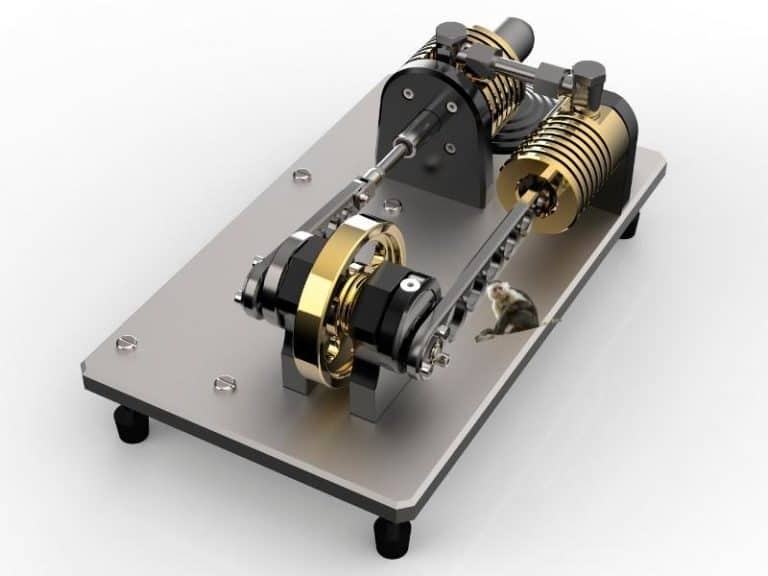Solar Stirling engines use a dish to capture light and heat air drawn into a cylinder by a vacuum pump, expanding and pushing against a piston.
On the other hand, solar panels use photovoltaic cells that convert sunlight into electricity through the photoelectric effect.
Solar Stirling engines have been offered as an alternative to typical solar panel setups. They are hailed because of their efficiency, durability, and cost-effectiveness.
This article will compare and contrast solar Stirling engines to solar panels and how they work.

What Is a Solar Stirling Engine?
The solar Stirling engine is a thermal solar power reciprocating piston engine. The engine has a higher efficiency than a gasoline or diesel engine.
The Stirling engine is based on the external combustion engine invented by Scottish minister Robert Stirling in 1816. His company manufactured the Stirling cycle engine from 1818 to 1922.
How Does a Solar Stirling Engine Work?
A solar Stirling engine consists of a hot end where the sunlight is absorbed and a cold end that absorbs heat from the environment. A displacer moves the air or other gas in one direction to transfer energy between these two ends.
The heated air causes an expansion at the hot end due to lower atmospheric pressure there; it then gets pulled to the cold end, where it is compressed since atmospheric pressure there is higher.
The displacer then moves to compress and expand the air in a different direction so that this cycle can repeat itself.
A solar Stirling engine consists of four main components: cylinder (and lid), displacer, hot end (receiver), and cold end (radiator). The cylinder and lid are typically made of metal.
The working fluid is usually air or helium gas, though it could be water vapor if pressurized.
See also: Alternatives To Solar Panels For The Home (Great Options)
Stirling Engine Generator V.s Solar Panel – Diagram

The Pros and Cons of Solar Stirling Engines
Solar Stirling engines are a form of clean, renewable energy technology that converts solar radiation into electricity. This technology has both pros and cons depending on the engine type and its size and the environment in which it is used.
The pros of solar Stirling engines are that they have great potential for large-scale, grid-connected power generation.
These engines can also be used in situations where there isn’t access to fuel or electricity and are thus extremely useful in cases where the ability to generate power is limited.
However, these engines are currently being used mainly for smaller-scale applications such as water pumping or powering lights at remote sites because of their high cost and difficulty of implementation on a large scale.
The size needed for more extensive projects also makes them unsuitable for many commercial uses because they require a large area.
There are several other benefits and drawbacks of this technology, which are worth noting:
PROS:
- It is a highly efficient energy production system due to hot and cold sources.
- It uses several hot sources to heat the gas, such as wood, sawdust, solar or geothermal energy, waste, etc.
- It is more ecological as it does not contribute to gas emissions.
- They require little maintenance.
CONS:
- It requires time to warm up before running.
- Alternative power sources are more competitive in price.
- There are no standardized models, which makes them more expensive to produce.
What Is a Solar Panel?
An array of solar cells is used to generate electricity from the sun’s rays with a solar panel. A single solar cell cannot do this, but enough cells can create a system that generates energy. The cells are connected in a series to make a module.
A solar panel or photovoltaic cell (PV) comprises many smaller units called PV cells, which use light from the sun to produce electricity.
When sunlight strikes an atom in a crystal lattice, it frees an electron, allowing it to move through the crystal. Electricity is created by letting electrons flow in a circuit between PV cells.
How Do Solar Panels Work?
Solar panels collect sunlight and use it to generate electricity. These photovoltaic cells create an electric field when photons (particles of light) interact with electrons (particles of electricity) in semiconductors like silicon.
The resulting flow of electrons creates an electric field across a gap separating two conductors – one on each side of the cell.
When the solar panel is connected to a circuit, electricity can flow through it. When sunlight is readily available, the electric field produced by the solar panel creates a difference in voltage between its terminals.
The panels can convert potential energy into direct-current (DC) electricity by using electrical components.
The Pros and Cons of Solar Panels
Solar panels have some downsides, even though they are a great source of renewable energy. One of the most significant advantages of solar panels is their environmental friendliness and zero emissions.
They are also cost-effective for people who cannot afford other sources of power or those with limited access to electricity.
However, there are still some disadvantages to solar panels as well. They can be expensive upfront even though their maintenance costs over time may be lower than other types of green power sources.
Pros:
- Solar panels are more efficient than fossil fuel plants.
- Their environmental impact is much less than that of coal, natural gas, or diesel engines.
- Solar Panels produce electricity without producing greenhouse gases.
- The average lifespan for solar cells is 25 years.
Cons:
- Higher initial investment costs, although the lifetime cost of solar panels is very low.
- Solar cells require a lot of space and produce less energy in the winter months when there isn’t much sunlight, so they aren’t suitable for all climates.
- Their efficiency decreases over time as dust builds up on their surface, causing power loss; this requires maintenance to keep them at their peak.
- Some people still think solar panels are expensive and an eyesore that would decrease a home’s value.
- Solar cells cannot produce electricity at night because they require sunlight.
Sources



